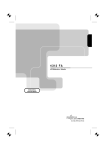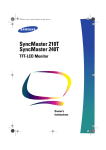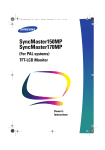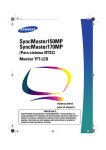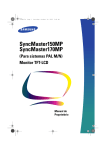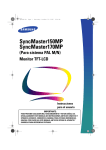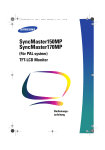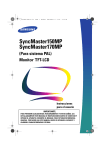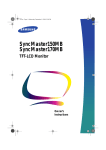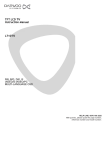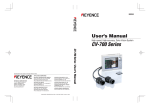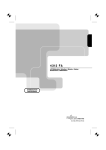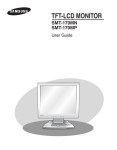Download Samsung 150MP Computer Monitor User Manual
Transcript
COVER.fm Page 1 Thursday, July 6, 2000 10:43 AM SyncMaster150MP SyncMaster170MP (For NTSC systems) TFT-LCD Monitor Owner’s Instructions COVER.fm Page 2 Thursday, July 6, 2000 10:43 AM Information in this document is subject to change without notice. © 2000 Samsung Electronics Co., Ltd. All rights reserved. Reproduction in any manner whatsoever without the written permission of Samsung Electronics Co., Ltd. is strictly forbidden. Samsung Electronics Co., Ltd. shall not be liable for errors contained herein or for incidental or consequential damages in connection with the furnishing, performance, or use of this material. The Samsung logo and SyncMaster are registered trademarks of Samsung Electronics Co., Ltd.; Microsoft, Windows ® and Windows® NT are registered trademarks of Microsoft Corporation; VESA, DPMS and DDC are registered trademarks of Video Electronics Standard Association; the ENERGY STAR name and logo are registered trademarks of the U.S. Environmental Protection Agency (EPA). As an ENERGY STAR Partner, Samsung Electronics Co., Ltd. has determined that this product meets the ENERGY STAR guidelines for energy efficiency. All other product names mentioned herein may be the trademarks or registered trademarks of their respective owners. English 1 Français Safety Instructions. . . . . . . . . . . . . . . . . . . . . . . . . . . . . . . . . . . . . . . . . . . . . . . . . . . . . . . . . . . 2 Unpacking your Monitor . . . . . . . . . . . . . . . . . . . . . . . . . . . . . . . . . . . . . . . . . . . . . . . . . . . . . . 3 Setting up Your LCD Monitor . . . . . . . . . . . . . . . . . . . . . . . . . . . . . . . . . . . . . . . . . . . . . . . . . 4 Setting up an Ergonomic Workstation . . . . . . . . . . . . . . . . . . . . . . . . . . . . . . . . . . . . . . . 4 Monitor Location . . . . . . . . . . . . . . . . . . . . . . . . . . . . . . . . . . . . . . . . . . . . . . . . . . . . 4 Workstation Height . . . . . . . . . . . . . . . . . . . . . . . . . . . . . . . . . . . . . . . . . . . . . . . . . . 4 Viewing Angle . . . . . . . . . . . . . . . . . . . . . . . . . . . . . . . . . . . . . . . . . . . . . . . . . . . . . . 4 Kensington Security Slot . . . . . . . . . . . . . . . . . . . . . . . . . . . . . . . . . . . . . . . . . . . . . . . . . 4 Connecting Your LCD Monitor . . . . . . . . . . . . . . . . . . . . . . . . . . . . . . . . . . . . . . . . . . . . 5 Plug and Play . . . . . . . . . . . . . . . . . . . . . . . . . . . . . . . . . . . . . . . . . . . . . . . . . . . . . . . . . . 6 Installing the Video Driver . . . . . . . . . . . . . . . . . . . . . . . . . . . . . . . . . . . . . . . . . . . . . . . . 6 Self-Test Feature Check (STFC) . . . . . . . . . . . . . . . . . . . . . . . . . . . . . . . . . . . . . . . . . . . . . . 6 Getting Help . . . . . . . . . . . . . . . . . . . . . . . . . . . . . . . . . . . . . . . . . . . . . . . . . . . . . . . . . . 7 Warm-up Time . . . . . . . . . . . . . . . . . . . . . . . . . . . . . . . . . . . . . . . . . . . . . . . . . . . . . . . . . 7 Adjusting Your LCD Monitor . . . . . . . . . . . . . . . . . . . . . . . . . . . . . . . . . . . . . . . . . . . . . . . . . . 8 User Controls . . . . . . . . . . . . . . . . . . . . . . . . . . . . . . . . . . . . . . . . . . . . . . . . . . . . . . . . . . 8 Automatic Save . . . . . . . . . . . . . . . . . . . . . . . . . . . . . . . . . . . . . . . . . . . . . . . . . . . . . . . . . . 9 Direct-Access Features . . . . . . . . . . . . . . . . . . . . . . . . . . . . . . . . . . . . . . . . . . . . . . . . . 10 OSD Lock/Unlock. . . . . . . . . . . . . . . . . . . . . . . . . . . . . . . . . . . . . . . . . . . . . . . . . . . . . 10 ON-Screen Display (OSD) . . . . . . . . . . . . . . . . . . . . . . . . . . . . . . . . . . . . . . . . . . . . . . . . . 11 Accessing the Menu System . . . . . . . . . . . . . . . . . . . . . . . . . . . . . . . . . . . . . . . . . . . 11 OSD Functions and Adjustments . . . . . . . . . . . . . . . . . . . . . . . . . . . . . . . . . . . . . . 12 Appendix . . . . . . . . . . . . . . . . . . . . . . . . . . . . . . . . . . . . . . . . . . . . . . . . . . . . . . . . . . . . . . . . 20 V-Chip . . . . . . . . . . . . . . . . . . . . . . . . . . . . . . . . . . . . . . . . . . . . . . . . . . . . . . . . . . . . . . . . 20 By Remote-Control . . . . . . . . . . . . . . . . . . . . . . . . . . . . . . . . . . . . . . . . . . . . . . . . . . . . . 22 Power Saver . . . . . . . . . . . . . . . . . . . . . . . . . . . . . . . . . . . . . . . . . . . . . . . . . . . . . . . . . . . 23 Troubleshooting . . . . . . . . . . . . . . . . . . . . . . . . . . . . . . . . . . . . . . . . . . . . . . . . . . . . . . . 24 Specifications . . . . . . . . . . . . . . . . . . . . . . . . . . . . . . . . . . . . . . . . . . . . . . . . . . . . . . . . 27 Pin Assignmments. . . . . . . . . . . . . . . . . . . . . . . . . . . . . . . . . . . . . . . . . . . . . . . . . . . . . . 29 Display Modes. . . . . . . . . . . . . . . . . . . . . . . . . . . . . . . . . . . . . . . . . . . . . . . . . . . . . . . . . . 30 NTSC Broadcasting Systems. . . . . . . . . . . . . . . . . . . . . . . . . . . . . . . . . . . . . . . . . . . . . . . 30 Installing VESA Compliant Mounting Devices . . . . . . . . . . . . . . . . . . . . . . . . . . . . . . . . 31 Wall Mount Instructions . . . . . . . . . . . . . . . . . . . . . . . . . . . . . . . . . . . . . . . . . . . . . . . 31 Retractable Stand . . . . . . . . . . . . . . . . . . . . . . . . . . . . . . . . . . . . . . . . . . . . . . . . . . . . . . . 32 Maintenance of Your LCD Monitor . . . . . . . . . . . . . . . . . . . . . . . . . . . . . . . . . . . . . . . . . 32 Attaching a Wall or Arm Mounting Device. . . . . . . . . . . . . . . . . . . . . . . . . . . . . . . . . . . . 33 Index . . . . . . . . . . . . . . . . . . . . . . . . . . . . . . . . . . . . . . . . . . . . . . . . . . . . . . . . . . . . . . . . . . . 34 Regulatory Information . . . . . . . . . . . . . . . . . . . . . . . . . . . . . . . . . . . . . . . . . Inside back cover Customer Service / Technical Support . . . . . . . . . . . . . . . . . . . . . . . . . . . . . . . . . . . Back cover Deutsch Table of Contents English 10:48 AM Español Thursday, July 6, 2000 Italiano Page 1 Portu- TOC.fm Safety.fm Page 2 Thursday, July 6, 2000 10:55 AM Safety Instructions 1 2 3 4 5 Before connecting the AC power cord to the DC adapter outlet, make sure the voltage designation of the DC adapter corresponds to the local electrical supply. Never insert anything metallic into the cabinet openings of the liquid cristal display (LCD) monitor; doing so may create the danger of electric shock. To avoid electric shock, never touch the inside of the LCD monitor. Only a qualified technician should open the case of the LCD monitor. Never use your LCD monitor if the power cord has been damaged. Do not allow anything to rest on the power cord, and keep the cord away from areas where people can trip over it. Be sure to hold the plug, not the cord, when disconnecting the LCD monitor from an electric socket. 6 Openings in the LCD monitor cabinet are provided for ventilation. To prevent overheating, these openings should not be blocked or covered. Also, avoid using the LCD monitor on a bed, sofa, rug, or other soft surface. Doing so may block the ventilation openings in the bottom of the cabinet. If you put the LCD monitor in a bookcase or some other enclosed space, be sure to provide adequate ventilation. Put your LCD monitor in a location with low humidity and a minimum of dust. 7 8 9 10 11 12 13 14 Do not expose the LCD monitor to rain or use it near water (in kitchens, near swimming pools, etc.). If the LCD monitor accidentally gets wet, unplug it and contact an authorized dealer immediately. You can clean the LCD monitor with a damp cloth when necessary, but be sure to unplug the LCD monitor first. Place the LCD monitor on a solid surface and treat it carefully. The screen is made of thin glass with a plastic front surface and can be damaged if dropped, hit or scratched. Do not clean the front panel with keton-type materials (e.g., acetone), ethyl alcohol, toluene, ethyl acid, methyl, or chloride – these may damage the panel. Locate your LCD monitor near an easily accessible AC outlet. If your LCD monitor does not operate normally – in particular, if there are any unusual sounds or smells coming from it – unplug it immediately and contact an authorized dealer or service center. High temperature can cause problems. Don’t use your LCD monitor in direct sunlight, and keep it away from heaters, stoves, fireplaces, and other sources of heat. Unplug the LCD monitor when it is going to be left unused for an extended period of time. Unplug your LCD monitor from the AC outlet before any service. CAUTION RISK OF ELECTRIC SHOCK DO NOT OPEN CAUTION: TO REDUCE THE RISK OF ELECTRIC SHOCK, DO NOT REMOVE COVER (OR BACK). NO USER-SERVICEABLE PARTS INSIDE. REFER SERVICING TO QUALIFIED SERVICE PERSONNEL. English 2 108E05body2.fm Page 3 Monday, August 6, 2001 1:53 PM Please make sure the following items are included with your monitor. If any items are missing, contact your dealer. Power Cord 15-pin D-Sub Signal Cable Français Installation CD English Unpacking Your Monitor Warranty Card (not available in all locations) DC Adapter SyncMaster 150MP Manual Source PIP Exit Menu CH VOL Monitor Stereo-RCA Cable (option) 3 1 2 4 5 7 8 9 Display 0 Pre.CH Deutsch PC V1 V2 TV PAL-NTSC Connector Batteries (AAA x 2) Italiano Stereo-Stereo Cable English 3 Portuguese Remote Controller Español 6 108E05body2.fm Page 4 Monday, August 6, 2001 1:53 PM Setting up Your LCD Monitor Setting up an Ergonomic Workstation Consider the advice given below before you install your monitor. Monitor location Choose a position that exposes your monitor to the least reflection from lights or windows, usually at a right angle to any window. Workstation height Place your LCD monitor so that the top of the screen is slightly below your eye level when you are comfortably seated. Viewing angle Tilt the screen until you feel comfortable working with your monitor. Figure 1. Tilt the screen Kensington Security Slot This monitor offers you the opportunity to secure your monitor using a Kensington-type security device. Kensington lock is not included. Refer to your locking device documentation for installation instructions. Figure 2. Kensington-type security slot location English 4 108E05body2.fm Page 5 Monday, August 6, 2001 1:53 PM Connecting Your LCD Monitor IN 1 2 3 4 OUT 5 6 7 Français English Setting up Your LCD Monitor Connect the power cord to the DC adapter and connect the adapter jack to the DC12V power port on the back of your monitor. Connect the signal cable to the video port on your computer. Connect the RCA cable or S-VHS cable to your DVD, VCR or camcoder. (RCA cable & S-VHS cable not included) Connect the audio sources(computer, DVD, VCR or Camcoder) to proper Audio input ports(Ain(L), Ain(R) or Ain(stereo)). Connect your external audio system to the Line-out port. Connect your headphone to the Headphone-out port. Connect antenna or CATV cable to “ Antenna” port. PAL-NTSC connector NTSC coaxial cable connector 8 9 10 Turn on both your computer and the monitor. If necessary, install the video driver for the monitor. (See “Installing the video driver” on page 6) After your monitor has been fully installed successfully, run Auto-Adjustment. (See page12) English 5 Italiano NOTE: US and other NTSC broadcasting regions must use PAL-NTSC connector that comes with your monitor. Portuguese 1 2 3 4 5 6 7 Español Figure 3. Cable connections Deutsch DVD or VCR body2.fm Page 6 Tuesday, August 29, 2000 2:21 PM Setting up Your LCD Monitor Plug and Play The adoption of the new VESA® Plug and Play solution eliminates complicated and time consuming setup. It allows you to install your monitor in a Plug and Play compatible system without the usual hassles and confusion. Your PC system can easily identify and configure itself for use with your display. This monitor automatically tells the PC system its Extended Display Identification Data (EDID) using Display Data Channel (DDC) protocols so the PC system can automatically configure itself to use the flat panel display. If your PC system needs a video driver, follow the instructions given below according to the operating system your computer uses. Installing the Video Driver The CD that accompanies this product contains the necessary drivers for installing your monitor. Please refer to the driver installation instructions included with your CD package for more information. Self-Test Feature Check (STFC) Your monitor provides a self-test feature that allows you to check whether your monitor is functioning properly. Make sure that PC is selected as a primary source by checking if the source indicator LED labeled “PC” is on. If your monitor and computer are properly connected but the monitor screen remains dark and the power indicator is blinking, run the monitor self-test by following the steps given below: Power Indicator Figure 4. Power Indicator 1 Turn off both your computer and the monitor. 2 Unplug the video cable from the back of the computer. 3 Turn on the monitor. English 6 body2.fm Page 7 Tuesday, August 29, 2000 2:21 PM Check Signal Cable Figure 5. Monitor self-test screen Français If the monitor is functioning properly, you will see a white box with a large blue oval Samsung logo and an error messsage “Check Signal Cable.” in red color. English Setting up Your LCD Monitor 4 Turn off your monitor and reconnect the video cable; then turn on both your computer and the monitor. If your monitor screen remains blank after following the previous procedure, check your video controller and computer system; your monitor is functioning properly. Deutsch This box also appears during normal operation if the video cable becomes disconnected or damaged. If your monitor does not display an image, check your cable connections and refer to "Troubleshooting" on page 24. If you experience difficulties with the quality of the displayed image, run Auto Adjustment (see page 12) and refer to "Adjusting Your LCD Monitor " on page 8 or "Troubleshooting" on page 24. Español Getting Help English 7 Portuguese All LCD monitors need time to become thermally stable whenever you turn on the monitor after letting the monitor be turned off for a couple of hours. Therefore, to achieve more accurate adjustments for parameters, allow the LCD monitor to warm (be on) for at least 20 minutes before making any screen adjustments. Italiano Warm-up Time body2.fm Page 8 Tuesday, August 29, 2000 2:21 PM Adjusting Your LCD Monitor User Controls Your LCD monitor allows you to easily adjust the characteristics of the image being displayed. All of these adjustments are made using the control buttons on the front of the monitor. While you use these buttons to adjust the controls, an on-screen menu shows you their numeric values as they change. PC V1 V2 TV Source PIP Exit Menu CH VOL * 17" : SyncMaster 170MP Figure 6. User control locations No. Name Description ■ 1 Source ■ ■ 2 PIP ■ ■ ■ 3 Exit ■ ■ 4 Menu Power Activates PIP(Picture-in-Picture) window directly. PIP to Fullscreen video. PIP off. Exits from menus and sub-menus. Exits from the OSD system. Turns the PIP off. ■ Opens the OSD and selects the highlighted function. ■ Turns ON/OFF the monitor. Indicates the status of the monitor. -Green : Normal Operation. -Amber : Power Saving Mode or Disconnected Signal Cable. ■ 5 Selects Video source. Four source indicator LEDs on the left of the control button indicate currently active Video source. English 8 body2.fm Page 9 Tuesday, August 29, 2000 2:21 PM No. Name Description ■ Moves the selector up or down on the OSD. ■ Increases or decreases the channel number. ■ Moves the selector left or right on the OSD. Increases or decreases the values of the selected function. English Adjusting Your LCD Monitor - CH + ■ 7 - VOL + ■ Increases or decreases the level of audio volume. Français 6 English 9 Portuguese Italiano Español Whenever you open the on-screen menu and allow an adjustment window to remain active for about 3 seconds without pressing other buttons, the monitor automatically saves any adjustment you have made. These changes are saved into a user area in the monitor. The monitor can save adjustments for up to 5 user modes. It has 9 for 150MP (11 for 170MP ) factory preset or preload modes, one for each signal frequency as listed in table 7 on page 30. If you have made no adjustments, the on-screen menu disappears and the monitor does not save anything. Deutsch Automatic Save body2.fm Page 10 Tuesday, August 29, 2000 2:21 PM Adjusting Your LCD Monitor Direct-Access Features While you are watching full screen TV or in PIP mode Ch._ Channel When OSD is not on the screen, push the " " " button to select channel number. 1 Push the " number. 2 Push the " " button to increase the channel number. "button to decrease channel When OSD is not on the screen, push the " or " " button to adjust volume. Volume 50 " or 1 Push the " volume. " button to decrease the 2 Push the " volume. " button to increase the " OSD Lock/Unlock This function allows you to secure the current settings so that they cannot be inadvertently changed, while still allowing you to adjust the Brightness, Contrast, Channel, and Volume. You can unlock the OSD controls at any time by using the same procedure. With the OSD screen off, push and hold the Menu button for at least 5 seconds to lock or unlock the controls. When locked, a 'LOCKED!' message will be displayed along the bottom of each OSD menu except for these screens : •Brightness •Contrast •Channel •Volume English 10 body2.fm Page 11 Tuesday, August 29, 2000 2:21 PM English Adjusting Your LCD Monitor ON-Screen Display(OSD) AUTO AUTO ADJUSTMENT Function name Setting bar Auto Adjustment Press Menu Key Deutsch Tool Tip Figure 7. On-Screen Display(OSD) Accessing the menu system NOTE: The numeric value indicator is provided as a point of reference only and has nothing to do with a real measurement. 6 Push the Exit button a couple of times to return to the main menu to select another function or to exit from the OSD. English 11 Español Use the " " buttons to move from one function to another. As you move from one icon to another, the function name changes to reflect the function or group of functions represented by that icon. See Table 1 starting on the next page to view a complete list of all of the functions available for the monitor. Press the Menu button once to activate the highlighted function, then follow the Tool Tips to select the function and adjust the value. Use " " and " " buttons to select the sub-menu, and press the Menu button once to activate the selected sub-menu. After selecting a function, use the " " and " " buttons to make necessary adjustments. The setting bar moves and the numeric value indicator changes to reflect your adjustments. Italiano 3 4 5 With the OSD off, push the Menu button to display the main OSD menu. Portuguese 1 2 Français Function icons body2.fm Page 12 Tuesday, August 29, 2000 2:21 PM Adjusting Your LCD Monitor OSD functions and adjustment Table 1. Screen controls Icon Menus and Sub-menus Function Descriptions Auto Adjustment "Auto adjustment" allows the monitor to self-adjust to the incoming video signal. The values of fine, coarse and position are adjusted automatically. AUTO Contrast SyncMaster 150MP PC V1 V2 TV Source PIP Exit Menu CH SyncMaster 150MP VOL PC V1 V2 TV Source PIP Exit Menu CH VOL Brightness SyncMaster 150MP SyncMaster 150MP PC V1 V2 TV Source PIP Exit Menu CH VOL PC V1 V2 TV Image Lock Source PIP Exit Menu CH VOL Image Lock is used to fine tune and get the best image by removing noises that creates unstable images with jitters and shimmers. English 12 body2.fm Page 13 Tuesday, August 29, 2000 2:21 PM Table 1. Screen controls (Continued ) Function Descriptions Menus and Sub-menus Icon ■ ■ Fine Coarse The Fine and Coarse adjustments allow you to fine tune the image quality of your monitor to your preference. Use the " " and " " buttons to remove any noise. If satisfactory results are not obtained using the Fine adjustment, use the Coarse adjustment and then use Fine again. This function may change the width of the image. Use the H-Position menu to center the image on the screen. When Coarse value is wrong ■ Information Display current display mode. ■ Reset Image lock and position parameters are replaced with the factory default values. Español Deutsch When Fine value is wrong Français English Adjusting Your LCD Monitor SyncMaster 150MP SyncMaster 150MP PC V1 V2 TV PC V1 V2 TV Source PIP Exit Menu CH Source PIP Exit Menu CH VOL Source PIP Exit Menu CH VOL VOL Italiano H-Position SyncMaster 150MP PC V1 V2 TV Source PIP Exit Menu CH SyncMaster 150MP VOL PC V1 V2 TV English 13 Portuguese V-Position body2.fm Page 14 Tuesday, August 29, 2000 2:21 PM Adjusting Your LCD Monitor Table 1. Screen controls (Continued ) Function Descriptions Menus and Sub-menus Icon Color The tone of color can be changed from redish white to bluish white. The individual color components are also user customizable. ■ Mode1 Redish white. ■ Mode2 Plain white. ■ Mode3 Bluish white. ■ User Mode User customizable. ■ Reset Color parameters are replaced with the factory default values. PIP(Picture-inPicture) When external A/V devices such as VCR, DVD or RF(TV)cable are connected to the monitor, PIP allows you to watch video from such devices in a small window super-imposed on pc video signal. ■ Size Resize PIP window. ■ Position Change PIP window position. TV Setup ■ Channel system The channel system can be set in several different ways. Select a channel system that is being used in your region. (See "NTSC broadcasting systems" on page 30) • US-Air • US-Cable • Japan-Air • Japan-Cable Upon selecting a channel system, you will be asked if you want to perform "Channel auto program ". Select "OK " to perform the "Channel auto program " or select "Cancel" to select different channel system. (See page 19 for "Channel auto program".) English 14 body2.fm Page 15 Tuesday, August 29, 2000 2:21 PM In rare cases, "Channel auto program" may miss a couple of channels due to weak signals or for other reasons such as a channel does not exist when "Channel auto program" is executed. To add a newly found channel or remove a channel, please follow the steps described below. • Push Menu button and then select "Channel Edit" under "TV Setup" menu. • Select "Add" to add the channel or select "Erase" to remove the channel. ■ Fine Tune Due to weak signals or a wrong antenna configuration, some of the channels may not be tuned correctly. Select "Fine Tune" under TV Setup menu to make the video image as clear as possible. " to fine tune the quality of video • Use " images when you satisfy with the setting, press " " to highlight "Save" or "Cancel" menu. • Select "Save" to save or "Cancel" to cancel the setting. ■ Stereo System Due to the various encoding schemes, the audio system corresponding to the channel system must be selected manually. Currently, there are three stereo audio systems in NTSC system: A2, BTSC and EIAJ. Please select the stereo audio system that is applicable to your region. • A2: Korea • BTSC: Most regions using NTSC System including USA, Canada, Chile, Venezuela, and Taiwan • EIAJ: Japan (See "NTSC broadcasting systems" on page 30) NOTE: BTSC: Broadcast Television System Committee. EIAJ: Electronic Industries Association of Japan. English 15 Français Channel Edit Deutsch ■ Español Function Descriptions Italiano Menus and Sub-menus Icon Portuguese Table 1. Screen controls (Continued ) English Adjusting Your LCD Monitor body2.fm Page 16 Tuesday, August 29, 2000 2:21 PM Adjusting Your LCD Monitor Table 1. Screen controls (Continued ) Function Descriptions Menus and Sub-menus Icon ■ Closed Caption (US only) Enable or disable closed caption feature and set the appearance of closed caption text. • • • • • ■ V- Chip Video Control On/Off Caption/Text Channel 1/2 Field 1/2 Box/Shadow See " V- Chip " on page 20 ~ 21. This function is active if you select an input source other than PC. (DVD, VCR, TV) ■ Contrast Adjust the contrast of video or TV without affecting PC RGB’s contrast. ■ Brightness Adjust the brightness of video or TV without affecting PC RGB’s brightness. ■ Sharpness Adjust the sharpness of video or TV image. ■ Tint Change the tone of color. ■ Color Change the richness of color. English 16 body2.fm Page 17 Tuesday, August 29, 2000 2:21 PM ■ Source Select Selects a sound source from PC, DVD, VCR or TV. ■ Bass Bass: Emphasize low frequency audio. ■ Treble Treble: Emphasize high frequency audio. ■ Stereo/Mono/ SAP Stereo: Process stereo sound if available. Mono: Process sound as mono. For stereo sound left and right channels are merged to be processed as mono. SAP: Select the language you want to hear for MTS system. NOTE: SAP : Second Audio Program MTS : Multi - Television Sound ■ Speaker mute Mutes the sound temporarily. NOTE: Mute is released when you change channel, adjust volume, activate PIP or access MTS menu via either the monitor or the remote controller. The size of the image being displayed can be handled in several different ways. ■ Expand1 Resize the image to fill the whole screen. (applicable to PC RGB only : 150MP) (applicable to both PC RGB and video : 170MP) ■ Expand2 Expand images keeping the original aspect ratio. (applicable to PC RGB only : 150MP) (applicable to both PC RGB and video : 170MP) ■ Normal Display the incoming image as it is. (applicable to PC RGB only : 150MP) (applicable to both PC RGB and video : 170MP) English 17 Italiano Image Size Français The monitor has a built-in high fidelity stereo audio amplifier. The audio circuit processes audio signal from various external input sources such as DVD, VCR, TV or PC. Portuguese Audio Control Deutsch Function Descriptions Menus and Sub-menus Icon Español Table 1. Screen controls (Continued ) English Adjusting Your LCD Monitor body2.fm Page 18 Tuesday, August 29, 2000 2:21 PM Adjusting Your LCD Monitor Table 1. Screen controls (Continued ) Function Descriptions Menus and Sub-menus Icon ■ Zoom The image can be magnified up to 64 times larger than the original image. The enlarged image can also be panned. ■ Pan Move the zoomed image horizontally and vertically. Image Effect Timer Image being displayed can be made softer or sharper. • Sharpen more • Sharpen • Medium • Soften • Soften more The monitor system will turn off automatically if one of three time intervals is selected. 30 min. 60 min. 120 min. OSD Control OSD language and appearence can be changed. ■ Language English Español ■ Position Move the OSD Window to the vertical and horizontal direction. ■ Halftone Change the opaqueness of the background of the OSD. ■ Duration The number of seconds that the OSD will remain visible before disappearing. English 18 body2.fm Page 19 Tuesday, August 29, 2000 2:21 PM English 19 Portuguese Italiano Español Deutsch *Upon completion of "Channel auto program", the result of the channel search is stored in designated internal memory. Each found channel is indexed into that memory and the channel indices are used as a look up table. In other words, when a user changes the channel, the monitor refers to the look up table to find the appropriate channel freqency instead of performing physical frequency scanning which gives a lot slower tuning result. In rare cases, "Channel auto program" may miss a channel due to weak signals or for other reasons. To add a channel, please enter the channel number by using the numeric key pads on the remote controller, then use "Fine Tune" menu in the "TV Setup" menu from OSD. When you finish fine tunning the channel you want to add, select "Save". Français * According to our R&D Lab test result, "Channel auto program" usually takes around 3 minutes to scan 61 channels. The scanning can be longer or shorter depending on the number of channels and the video source whether the video source is from cable or air. English Adjusting Your LCD Monitor body2.fm Page 20 Tuesday, August 29, 2000 2:21 PM Appendix V - Chip The Telecommunications Act of 1996 in USA requires that every television made, starting in 1998, must be equipped with the technological device named V - Chip. The V - Chip can block certain rated television shows off television (if chosen) so children cannot watch programs that their parents do not approve. With this device, program-rating information will be transmitted along with the television signal, and be decoded by the chip in each television. The chip will then compare the rating codes to values preset by the viewer, which is meant to be the parents. If the rating codes are higher than the preset values, the television signal will be blocked, and a blank screen will be displayed. SyncMaster 150/170MP have this feature and you can adjust the V - Chip setting via OSD. Use arrow keys on the remote controller or control buttons on the front cabinet of the monitor to change the setting. 1. Select V - Chip on OSD, then enter 4 digits of pin number. - Initial pin number is “0000” - If you enter an incorrect pin number “Incorrect” message will be displayed for 3 seconds. 2. Use arrow keys to change or to activate the highlighted function. 3. Setting up TV Guidelines - Use Up/Down/Left/Right arrow buttons to move around the matrix and press Menu button to change the value from "U" to "B" or "B" to "U" - U : Unblock B : Block All FV V S L D U TV-Y B TV-Y7 B TV-G U TV-PG U U U U TV-14 U U U U TV-MA U U U U B TV-Y : Young Children TV-Y7 : Children 7 and over TV-G : General Audience TV-PG : Parent Guidance TV-14 : Viewers 14 and over TV-MA : Mature audience FV : Fantasy Violence V : Violence S : Sexual Situation L : Coarse Language D : Suggestive Dialog English 20 body2.fm Page 21 Tuesday, August 29, 2000 2:21 PM General Guidance PG U Parental Guidance Suggested PG-13 U Parents Strongly Cautioned R U Restricted Under 17 Requires NC-17 U No Children Under 17 Admitted X U Adult Only NR U Not Rated 5. Entering a new pin number - Use numeric keys enter a new pin number. Pin number confirm menu appears. - Again, use numeric keys to enter the pin number you entered at the previous step. If the two pin numbers do not match, "Incorrect" message will be displayed for 3 seconds. 6. Blocking Screen - If the incoming signal’s rating is higher than the one specified, the screen will be blanked and "Excessive rating" message will be appeared. Français U Deutsch G Español 4. Setting up MPAA rating Mode - Use Up/Down/Left/Right arrow buttons to move around the matrix and press Menu button to change the value from "U" to "B" or "B" to "U" - MPAA : Motion Picture Association (of) America [movie rating organization] English Appendix English 21 Portuguese Italiano NOTE: When the screen is blocked by V-Chip, and if you want to change V-Chip setting, press Exit button on the remote control or on the front cabinet of the monitor to bring up OSD Menu. body2.fm Page 22 Tuesday, August 29, 2000 2:21 PM Appendix By Remote-Control Source • PC • V1 • V2 • TV Power On/Off PIP • PIP on • Full screen PIP Off • PIP PC • Full(PIP) PC Turn on the OSD Turn off the OSD 1 2 3 4 5 6 7 8 9 Display 0 Pre.CH PIP Position Display setup information (Channel, Stereo/Mono/SAP) Numeric keypads for direct channel access. Previous channel Sound mute Caption Channel search MTS-mode (USA) or S-mode (Europe) Volume Channel English 22 body2.fm Page 23 Tuesday, August 29, 2000 2:21 PM Power-Saving Function mode (EPA/NUTEK) Deep Sleep Mode Position A2 Horizontal Sync Vertical Sync Video Active Active Active Inactive Active Blanked Active Inactive Blanked Inactive Inactive Blanked Power Indicator Green Amber Amber Blinking Amber Blinking (0.5 sec interval) (1 sec. interval) Power Consumption 150MP : 33W (Max.) 170MP : 52W (Max.) Less than 3W Less than 3W Less than 3W NOTE: This monitor automatically returns to normal operation when horizontal and vertical sync return. This occurs when you move the computer’s mouse or press a key on the keyboard. This monitor is EPA ENERGY STAR® compliant and NUTEK compliant when used with a computer equipped with VESA DPMS functionality. For energy conservation, turn your monitor OFF when you are not using it or when leaving it unattended for long periods. English 23 Español Sleep Mode Position A1 Italiano Standby Mode Portuguese State Normal Operation Français This monitor has a built-in power management system called PowerSaver. This system saves energy by switching your monitor into a low-power mode when it has not been used for a certain period of time. The available modes are “On”, “Standby”, “Sleep”, and “Deep Sleep”. Power Saver operates with a VESA DPMS compliant video card installed in your computer. You use a software utility installed on your computer to set up this feature. See Table 2 below for details. Table 2. Power-saving modes Deutsch PowerSaver English Appendix body2.fm Page 24 Tuesday, August 29, 2000 2:21 PM Appendix Troubleshooting If you have a problem setting up or using your LCD monitor, you may be able to solve it yourself. Before contacting customer service, try the suggested actions that are appropriate to your problem. Table 3. Troubleshooting – Image What you see... Suggested Actions Reference Screen is blank and power indicator is off ■ Ensure that the power cord is firmly connected and the LCD monitor is on. Connecting your LCD monitor, page 5. “ Check Signal Cable” message ■ Ensure that the signal cable is firmly connected to the PC or video sources. Ensure that the PC or video sources are turned on. Connecting your LCD monitor, page 5. Check the maximum resolution and the frequency of the video adaptor. Compare these values with the data in the Display Modes Timing Chart. Display Modes, page 30. ■ “Sync. Out of Range” message ■ ■ The image is too light or too dark ■ Adjust the Brightness and Contrast. Brightness, page 12 Contrast, page 12. Horizontal bars appear to flicker, jitter or shimmer on the image ■ Adjust the Fine function. Image Lock, Fine, page 12 ~13. Vertical bars appear to flicker, jitter or shimmer on the image. ■ Adjust the Coarse function and then adjust the Fine function. Image Lock, Coarse, page 12~13. Image Lock, Fine, page 12~13. English 24 body2.fm Page 25 Tuesday, August 29, 2000 2:21 PM The monitor is using its power management system. Move the computer’s mouse or press a key on the keyboard Power Saver, page 23. Image is not stable and may appear to vibrate ■ Check that the display resolution and frequency from your PC or video board is an available mode for your monitor. On your computer check: Control Panel, Display, Settings Display Modes, page 30. ■ If the setting is not correct, use your computer utility program to change the display settings. Installing the Video Driver, page 6. ■ NOTE: Your monitor supports multiscan display functions within the following frequency domain: ■ Horizontal frequency: ■ Vertical frequency: ■ Maximum refresh rate: 150MP: 1024 x 768 @ 85 Hz 170MP: 1280 x 1024 @ 76Hz Image is not centered on the screen. ■ Adjust the horizontal and vertical position. H-Position, page 13. V-Position, page 13. You need the monitor driver software ■ Download the driver from WWW pages: http://samsungelectronics.com/ support/downloads/monitor/ index.html English 25 150MP : 30 kHz – 69 kHz 170MP : 30 kHz – 81kHz 56 Hz – 85 Hz Français ■ Deutsch Screen is blank and power indicator light is steady amber or blinks every 0.5 or 1 seconds Reference Español Suggested Actions Italiano What you see... Portuguese Table 3. Troubleshooting – Image (Continued ) English Appendix body2.fm Page 26 Tuesday, August 29, 2000 2:21 PM Appendix Table 4. Troubleshooting – Audio and TV Problem No sound Suggested Actions Reference ■ Ensure that the audio cable is firmly connected to both the audio-in port on your monitor and the audio–out port on your sound card. Connecting your LCD Monitor, page 5. ■ Check the volume level Audio Controls, page 17. ■ Check the volume level Audio Controls, page 17. ■ If the volume is still too low after turning the control to its maximum, check the volume control on the computer sound card or software program. Refer to your computer, sound card or software documentation. Sound is too high pitched or too low pitched ■ Adjust the Treble and Bass to appropriate level. Audio Controls, page 17. TV signal is not received ■ Check “Channel system” and make sure you choose the correct channel system. Select “Channel auto program” to configure the channel system automatically. See "NTSC broadcasting systems" on page 30. Sound level is too low ■ English 26 body2.fm Page 27 Tuesday, August 29, 2000 2:21 PM English Appendix Specifications Table 5. Technical and environmental specifications 17.0” Diagonal 338 (H) x 270 (V) mm a-si TFT active matrix 0.264 (H) x 0.264 (V) mm 70/70/60/60 (L/R/U/D) (Depending on the panel manufacturer, the viewing angle may be different from this spec.) 80/80/80/80 (L/R/U/D) (Depending on the panel manufacturer, the viewing angle may be different from this spec.) Horizontal Vertical 30 – 69 kHz 56 – 85 kHz Display color 16,777,216 colors 30 – 81 kHz 56 – 85 Hz (~XGA) 60 – 76 Hz (SXGA) 16,777,216 colors Optimum Mode 1024 x 768 @ 60 Hz Maximum 1024 x 768 @ 85 Hz Mode Input Signal Sync. H/V Separate, TTL, P. or N. H/V Composite, TTL, P. or N. Sync-on-green 0.3 Vp-p, N. 0.7 Vp-p @ 75 ohm Video signal TV, Video Color system Sound system Video format Power Supply Input Output Power Maximum Consumption Power Saving 1280 x 1024 @ 60 Hz 1280 x 1024 @ 76 Hz NTSC M/N CVBS, S-VHS AC 100-240 Vrms (50 ~ 60Hz ) DC 12V/3A AC 100-240 Vrms (50 ~ 60Hz ) DC 12V/4.5A 33 W <3W 52 W <3W * Referring to Standard signal modes, page 30. English 27 Español Display Resolution Français 15.0” Diagonal 304.1 (H) x 228.1 (V) mm a-si TFT active matrix 0.297 (H) x 0.297 (V) mm Italiano * Frequency Size Display Size Type Pixel pitch Viewing Angle Portuguese Panel 170MP Deutsch 150MP body2.fm Page 28 Tuesday, August 29, 2000 2:21 PM Appendix Table 5. Technical and environmental specifications 150MP Dimensions/ Weight Unit (WxHxD) : Monitor body With stand When folded Carton 170MP 17.6 x 17.2 x 2.48 inch / 14.3 lbs (448 x 438 x 63 mm / 6.5 Kg) 17.6 x 17.2 x 8.15 inch / 14.3 lbs (448 x 438 x 207 mm/ 6.5 Kg) 17.6 x 20.5 x 2.75 inch / 14.3 19.1 x 20.5 x 8.0 inch/ 15.4 lbs lbs (448 x 522x 70 mm/ 6.5 (486 x 522 x 203 mm / 7.0 Kg) Kg) 15.0 x 15.0 x 2.2 inch / 9.7 lbs (382 x 380 x 57 mm / 4.4 Kg ) 15.0 x 15.0 x 6.0 inch / 9.7 lbs (382 x 380 x 153 mm / 4.4 Kg) 15.0 x 17.7 x 2.4 inch / 9.7 lbs (382 x 450 x 61 mm / 4.4 Kg) 22.5 x 24.8 x 7.95 inch / 20.9 lbs (572 x 632 x 202 mm/ 9.5 Kg) Environmental Considerations Audio Characteristics Operating Temperature Operating Humidity Storage Temperature Storage Humidity Audio Input 1 Audio Input 2 Line-out (Audio out) Headphone out Frequency Response 50 ˚F to 104 ˚F (10 ˚C to 40 ˚C) 10% to 80% 13 ˚F to 113 ˚F (-25 ˚C to 45 ˚C) 5% to 95% RCA Jack Red(R) White(L), 0.5Vrms (-9dB) 3.5ø Stereo Jack, 0.5Vrms (-9dB) 3.5ø Stereo Jack, 0.7Vrms (-7dB) Max 10mW Output (3.5ø Stereo Jack 32Ω) RF: 80Hz - 15KHz (at- 3dB) A/V: 80Hz - 20KHz (at - 3dB) English 28 body2.fm Page 29 Tuesday, August 29, 2000 2:21 PM English Appendix Pin Assignments Table 6. 15 pin D-sub connector Red Red Red 2 Green Green Green + H/V Sync 3 Blue Blue Blue 4 GND GND GND 5 GND (DDC Return) GND (DDC Return) GND (DDC Return) 6 GND-Red GND-Red GND-Red 7 GND-Green GND-Green GND-Green 8 GND-Blue GND-Blue GND-Blue 9 No Connection No Connection Not used 10 GND-Sync/Self Test GND-Sync/Self Test GND-Sync/Self Test 11 GND GND GND 12 DDC _SDA DDC _SDA DDC _SDA 13 H_Sync H/V Sync Not used 14 V_ Sync Not used Not used 15 DDC _SCL DDC _SCL DDC _SCL English 29 Deutsch 1 Français Sync-on-green Español Composite H/V Italiano Separate H/V Portuguese Pin body2.fm Page 30 Tuesday, August 29, 2000 2:21 PM Appendix Display Modes If the signal from the system equals to the standard signal mode, the screen is adjusted automatically. If the signal from the system doesn't equal to the standard signal mode, adjust the mode with referring to the Videocard user guide because the screen might not display or only the power LED might be on. For the display modes listed below, the screen image has been optimized during manufacture. Table 7. Preset timing modes Mode VGA SVGA XGA SXGA (170MP only) Pixel Clock Sync Polarity Frequency (H/V) (MHz) Resolution Horizontal Frequency (kHz) Vertical Frequency (Hz) 720 x 400 31.469 70.087 28.322 –/+ 640 x 480 31.469 59.940 25.175 –/– 640 x 480 37.500 75.000 31.500 –/– 640 x 480 43.269 85.008 36.000 –/– 800 x 600 46.875 75.000 49.500 +/+ 800 x 600 53.674 85.061 56.250 +/+ 1024 x 768 48.363 60.004 65.000 –/– 1024 x 768 60.023 75.029 78.750 +/+ 1024 x 768 68.677 84.997 94.500 +/+ 1280 x 1024 63.981 60.020 108.000 +,–/+,– 1280 x 1024 79.976 75.025 135.000 +/+ Table 8. NTSC Broadcasting Systems Color System NTSC Sound System M Stereo System Channel System Countries A2 US Korea BTSC (SAP) US EIAJ Japan English 30 USA,Canada,Chile, Venezuela, Cuba, Colombia, Jamaica, Mexico, Panama, Peru, Philippines, Puerto-Rico, Taiwan Japan body2.fm Page 31 Tuesday, August 29, 2000 2:21 PM English Appendix Installing VESA compliant mounting devices Rear cover mounting pad Mounting Deutsch Français Refer to page 33 to fold the base Wall Mount Instructions The following instructions apply to a hollow sheet-rock wall only Tools/Hardware needed - Philips screwdriver, four toggle bolts, 5/8in dia. Drill bit and drill. Contact Ergotron at (800) 888-8458 to purchase the triple pivot direct mount adapter and wall mount bracket kit. Español Align the mounting interface pad with the holes in the rear cover mounting pad and secure it with the four screws that came with the arm-type base, wall mount hanger or other bases. No. 97 - 101 - 003 - 00 (Wall mount bracket kit) Align the wall mount bracket on the wall at the desired height, making sure that the bracket will be mounted between the wall studs. Mark the four corner openings and drill four 5/8-dia. holes. Assemble the wall mount kit according to the instructions provided with it. Securely attach Ergotron’s flat panel, triple pivot direct mount adapter to the back of the monitor using the four 4mm, .7 pitch x 10mm screws provided with the arm. Secure the assembly to the wall using four 3/16 by 3-inch long toggle bolts. English 31 Portuguese No. 97 - 101 - 003 (Wall mount bracket kit) • 170MP (17") : No. 47 - 007 - 099 - 02 (Pivot direct mount adapter) Italiano • 150MP (15") : No. 47 - 007 - 099 (Pivot direct mount adapter) body2.fm Page 32 Tuesday, August 29, 2000 2:21 PM English Appendix Retractable Stand English 32 Español WARNING: To avoid risk of electric shock, do not disassemble the monitor cabinet (except for gaining access to the cable connectors as described on page 5). Users cannot service the monitor. User maintenance is restricted to cleaning as explained below: Unplug the monitor from the power outlet before cleaning. To clean your flat panel display screen, lightly dampen a soft, clean cloth with ■ water or mild detergent. If possible, use a special screen cleaning tissue or solution suitable for the antistatic coating. ■ To clean the monitor cabinet, use a cloth lightly dampened with a mild detergent. ■ Never use flammable cleaning material to clean your LCD monitor or any other electrical apparatus. Italiano Maintenance of Your LCD monitor Portuguese NOTE: *Please pull the rear retractable part of the stand when you tilt the monitor to the backward direction to give more stability. The maximum tilt angle is 15 degree to the backward direction. Please do not tilt the monitor other than specified range. Excessive force to tilt the monitor other than specified range may give permanent damage to the mechanical part of the stand. Deutsch Français 15 body2.fm Page 33 Tuesday, August 29, 2000 2:21 PM Attaching a wall or Arm mounting device. Français The monitor supports VESA mounting standard for use with various VESA mounting devices. To install any VESA mounting device, please follow the instructions given. English Appendix 2 4 5 3 Lay the LCD monitor face-down on a flat surface with a cushion or other soft materials to protect the screen. Remove the connector cover Press “FOLD” button on the stand and tilt the monitor backward until the stand is in up -right position. Connect any cable you removed at step 3. Italiano Remove any cable connected on the monitor. Place the connector cover removed at step 2. Now you are ready to install Wall/Arm mounting device depending on your applications. English 33 Portuguese 1 2 3 4 5 6 7 6 Español Deutsch 1 IX.fm Page 34 Thursday, July 6, 2000 10:57 AM Index Numerics L 15-pin D-sub connector 29 Language 18 A N Audio control 17 Automatic Save 9 Auto adjustment 12 NTSC Broadcasting Systems 30 M Menu 8 Monitor self-test screen 7 B Brightness 12 O C OSD Lock/Unlock 10 ON-Screen Display 11 Cable connections 5 CH 9 Channel 10 Coarse 13 Color 14 Contrast 12 P PAL-NTSC connector 5 PIP 8, 14 Power 8 Power Indicator 6 Power-saving modes 23 D S DC adapter 3 Display Modes 30 Exit 8 Safety Instructions 2 Screen controls 12 Self-test feature check 6 F T Fine 13 Fine Tune 15 Function icons 11 Tilt the screen 4 Timer 18 Troubleshooting 24 H U H-position 13 User control locations 8 User mode 14 E I V Image lock 12 Image effect 18 Image size 17 Information 13 V - Chip 20 Video Control 16 VOL 9 Volume 10 V-position 13 K Kensington security slot 4 English 34 User Instructions The Federal Communications Commission Radio Frequency Interference Statement includes the following warning: Note: This equipment has been tested and found to comply with the limits for a Class B digital device, pursuant to Part 15 of the FCC Rules. These limits are designed to provide reasonable protection against harmful interference in a residential installation. This equipment generates, uses, and can radiate radio frequency energy and, if not installed and used in accordance with the instructions, may cause harmful interference to radio communications. However, there is no guarantee that interference will not occur in a particular installation. If this equipment does cause harmful interference to radio or television receptions, which can be determined by turning the equipment off and on, the user is encouraged to try to correct the interference by one or more of the following measures: ■ Reorient or relocate the receiving antenna. ■ Increase the separation between the equipment and receiver. ■ Connect the equipment into an outlet on a circuit different from that to which the receiver is connected. ■ Consult the dealer or an experienced radio/TV technician for help. User Information Changes or modifications not expressly approved by the party responsible for compliance could void the user’s authority to operate the equipment. If necessary, consult your dealer or an experienced radio/ television technician for additional suggestions. You may find the booklet called How to Identify and Resolve Radio/ TV Interference Problems helpful. This booklet was prepared by the Federal Communications Commission. It is available from the U.S. Government Printing Office, Washington, DC 20402, Stock Number 004-000-00345-4. Warning User must use shielded signal interface cables to maintain FCC compliance for the product. Declaration of conformity for products Marked with FCC Logo This device complies with Part 15 of the FCC Rules. Operation is subject to the following two conditions: (1) this device may not cause harmful interference, and (2) this device must accept any interference received, including interference that may cause undesired operation. The party responsible for product compliance: SAMSUNG ELECTRONICS CO., LTD America QA Lab of Samsung 85 West Tasman Drive San Jose, CA 95134 USA Tel) 408-544-5124 Fax) 408-544-5191 Provided with this monitor is a detachable power supply cord with IEC320 style terminations. It may be suitable for connection to any UL Listed personal computer with similar configuration. Before making the connection, make sure the voltage rating of the computer convenience outlet is the same as the monitor and that the ampere rating of the computer convenience outlet is equal to or exceeds the monitor voltage rating. For 120 Volt applications, use only UL Listed detachable power cord with NEMA configuration 5-15P type (parallel blades) plug cap. For 240 Volt applications use only UL Listed Detachable power supply cord with NEMA configuration 6-15P type (tandem blades) plug cap. Français FCC Information Deutsch Regulatory Information English 11:04 AM IC Compliance Notice This Class B digital apparatus meets all requirements of the Canadian Interference-Causing Equipment Regulations of ICES-003. Cet appareil Numérique de classe B respecte toutes les exigences du Règlemont ICES-003 sur les équipements produisant des interférences au Canada. Español Thursday, July 6, 2000 MPR II Compliance This monitor complies with SWEDAC(MPR II) recommendations for reduced electric and magnetic fields. European Notice Products with the CE Marking comply with both the EMC Directive (89/336/EEC), (92/31/EEC), (93/68/EEC) and the Low Voltage Directive (73/23/EEC) issued by the Commission of the European Community. Compliance with these directives implies conformity to the following European Norms: ■ EN55022 (CISPR 22) – Radio Frequency Interference ■ EN50082-1 : 1992 – Electromagnetic Immunity ■ EN60555-2 (IEC555-2) – Power Line Harmonics ■ EN60555-3 (IEC555-3) – Voltage Fluctuations ■ EN60950 (IEC950) – Product Safety. Italiano Page 0 Portuguese regulat.fm BkCov04.fm Page iv Thursday, July 6, 2000 10:42 AM U.S.A. : ESPAÑA : Samsung Electronics America (SEA) One Samsung Place Ledgewood, NJ 07852 Tel. : 1-800-SAMSUNG (1-800-726-7864) Samsung Electrónics Comercial Ibérica, S.A. Ciencies, 55-65 (Polígono Pedrosa) 08908 Hospitalet de Llobregat (Barcelona) Tel. : (93) 261 67 00 Fax. : (93) 261 67 50 CANADA : Samsung Electronics Canada Inc. 7037 Financial Drive Mississauga, Ontario L5N 6R3 Tel. : 1-800-SAMSUNG (1-800-726-7864) Fax. : (905) 542-1199 UK : Samsung Electronics GmbH Samsung-Haus Am Kronberger Hang 6/65824 Schwalbach/Ts. Tel. : 06196-66-1134 Fax. : 06196-66-1133 Samsung Electronics (UK) Ltd. Samsung House, 225 Hook Rise South Surbiton, Surrey KT6 7LD Tel. : (0181) 391 0168 Fax. : (0181) 397 9949 <European Service Center & National Service> Stafford Park 12 Telford, Shropshire, TF3 3BJ Tel. : (01952) 292 262 Fax. : (01952) 292 033 AUSTRALIA : THAILAND : GERMANY : Samsung Electronics Australia Pty Ltd. Unit G, 10-16 South Street, Rydalmere, N.S.W. 2116 P.O. BOX 368 Tel. : (02) 638-5200 ITALIA : Samsung Electronics Italia SpA Via C. Donat Cattin, 5-20063 Cernusco sul Naviglio (Mi) Tel. : 167-010740 PANAMA : Servicios Samsung (Zona Libre), S.A. 50 and 61 Streets Sta, Cecilia Bdl. Don Camilo, Panama City Tel. : (507) 264-0195 or 269-5571 Fax : (507) 269-5568 Samsung Service Center 729-729/1 JSP Tower Rachadapisek RD., Bangpongpang, Yannawa, Bangkok 10120 Tel : (662) 2954508-14 Fax : (662) 2954267 SOUTH AFRICA : Samsung Electronics South Africa Somerset Office Park 5 Libertas Road Bryanston, South Africa Tel : (27)-11-463-5678 Fax : (27)-11-463-5215 BRASIL : MEXICO Samsung Eletrônica da Amazonia Ltda. R. Prof. Manoelito de Ornellas, 303-2º Andar Chácara Sto. Antônio • cep : 04719-040 São Paulo • SP Tel. : (011) 541-8500 Fax : (011) 523-3995, 522-0726 Samsung Electronics Mexico S.A. de C.V. Saturno 44 Col. Nva. Industrial Vallejo Del. Gustavo A. Madero C.P. 07700 Mexico D.F. Tel. 5747-5100 RFC: SEM950215S98 Samsung Electronics Svenska, AB Box 713, S-194 27 Upplands Vasby Tel.: (468) 590-966-00 Fax : (468) 590-966-50 SWEDEN: IMPORTADO POR:SAMSUNG ELECTRONICS MEXICO S.A. DE C.V. SATURNO 44 COL. NVA. INDUSTRIAL VALLEJO DEL. GUSTAVO A. MADERO C.P. 07700 MEXICO D.F. TEL. 5747-5100 RFC: SEM950215S98 EXPORTADO POR: SAMSUNG ELECTRONICS CO.,LTD. JOONG-ANG DAILY NEWS BLDG. 7 SOON-WHA-DONG CHUNG-KU, C.P.O BOX 2775, 1144 SEOUL, KOREA “As an ENERGYSTAR® Partner, SAMSUNG has determined that this product meets the ENERGYSTAR® guidelines for energy efficiency.” P/N: BN68-00108E-04 Printed on recyclable paper






































